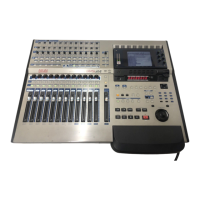2
OVERVIEW
DPS24 STRUCTURE
Internally, the DPS24 is laid out much like any conventional recording studio:
GroupTape
returns outs
Stereo
Out
2-trk
In
FX
Sends Returns
FX
PATCHBAYS
Monitor
Out
Nearfield
Out
(to LINE inputs/inserts)
Mics
(to MIC inputs)
FX RACK
2-TRACK
MTR
Main
Monitor
At the heart of this ‘typical’ studio is a large, multi-channel mixer. The mixer’s GROUP outputs are connected to the
inputs of the MTR (multi-track recorder) and inputs are routed to tracks on the MTR via these. The outputs of the
MTR are fed back into the mixer where the tracks can be mixed, EQ’d, etc. Microphones are connected to balanced
mic inputs on the mixer and line inputs are patched to the line inputs. The effects sends are connected to the effects
processors and the outputs of these are connected to the mixer’s effects return channels. The mixer’s stereo L/R
outputs are connected to a stereo mastering machine and its outputs are returned to the console’s 2-TRACK inputs
and monitored using the 2-TRACK switch on the console.
Monitor outputs feed an amplification system and, as is common in high-end studios, there are two monitor outputs
- one feeds the control room’s main monitoring system whilst another feeds a smaller monitoring system (maybe a
domestic hi-fi) for checking a mix on smaller speakers. Also in this typical studio (but not shown here) would be
compressors, noise gates and so forth.
If you are familiar with this setup, then you already understand most of the DPS24 as this is pretty much what the
DPS24 offers!
However, instead of separate analogue units, all the above is done digitally within the DPS24 so that you enjoy the
benefits of superior sound quality, automated mixing, non-destructive editing and much more besides in one
convenient unit.

